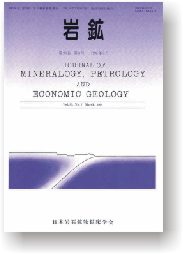All issues

Volume 94, Issue 5
May
Displaying 1-3 of 3 articles from this issue
- |<
- <
- 1
- >
- >|
ORIGINAL ARTICLES
-
Mitsuo SHIMAZU, Yoshinobu KAWANO1999 Volume 94 Issue 5 Pages 145-161
Published: 1999
Released on J-STAGE: August 07, 2006
JOURNAL FREE ACCESSMain volcanic rocks from North Sikhote Alin are the Late Eocene alkali and tholeiitic basalts, the Early Oligocene alkali and tholeiitic basalts, the Early Miocene calc-alkali andesites and latest Early Miocene shoshonites. Basalts of the Late Eocene and Early Oligocene are accompanied with calc-alkali andesites and dacites. The Late Eocene basalts have WPB character, whereas the Early Oligocene basalts and latest Early Miocene shoshonites have IAB character.
In the initial εNd-εSr diagram, the Late Eocene basalts have more higher Sr and lower Nd isotopic ratios than those of the Early Oligocene basalts and latest Early Miocene shoshonites. Sr isotopic ratios of the Sikhote Alin volcanic rocks have changed under 0.7040 at about 30 Ma.
From isotopic data, the Early Oligocene basalts and the latest Early Miocene shoshonites are inferred to have been derived from comparatively depleted mantle source and the Late Eocene basalts have been derived from more enriched source.
The Late Eocene alkali basalt volcanism took place in an immature rift zone occurred along the Asian continental margin at the embryonal stage of opening of the Japan Sea. Before the final stage of the opening, the Early Oligocene basalt and latest Early Miocene shoshonite volcanisms took place in relation to subduction of the North American plate and Pacific plate, respectively.View full abstractDownload PDF (1957K) -
Etsuo UCHIDA, Noriyuki MAEDA, Takeshi NAKAGAWA1999 Volume 94 Issue 5 Pages 162-175
Published: 1999
Released on J-STAGE: August 07, 2006
JOURNAL FREE ACCESSThe magnetic susceptibility, pore size, orientation of the bedding plane and chemical compositions of the laterites used in the Angkor momunents, Cambodia, were measured.
The laterites used as building blocks of the 25 main monuments can be classified into porous laterites and pisolitic laterites based on the texture. Main constituent minerals of the both type laterites are the same, that is, goethite, hematite, kaolinite and quartz. These laterites are supposed to be formed by weathering of sandstone and conglomerate.
Based on the average pore size and magnetic susceptibility of these laterites, the investigated monuments can be classified into 5 groups (Groups A to E) except for two monuments of Phnom Krom and Banteay Srei. This grouping is also supported by As, Sb, Sr and V contents of laterites. The laterites of the Groups A, C and E are rich in As, Sb and Sr, but poor in V compared with those of the Groups B and D. These facts suggest that the quarries from which the laterites were mined changed with the time.
The investigation of the bedding plane of the laterite blocks revealed that the percentage of the laterite blocks with the vertical bedding plane is high (about 30 to 75%) in the monuments constructed prior to Angkor Wat, but low (less than 14%) in Angkor Wat and subsequently constructed monuments.
Judging from the petrographic similarities of the laterites used for the embankments of the two ponds ajacent to Prasat Suor Prat and Khleangs, it is concluded that the ponds were constructed in the same age as Khleangs.View full abstractDownload PDF (5188K) -
Toshihiko ITO, Satoshi MATSUBARA, Ritsuro MIYAWAKI1999 Volume 94 Issue 5 Pages 176-182
Published: 1999
Released on J-STAGE: August 07, 2006
JOURNAL FREE ACCESSAt the calcareous sinter dome of Shiowakka, Hokkaido, spherulitic vaterite was found in the carbonate sediments in early spring. The aggregates of ikaite formed in winter have changed to sandy carbonate sediments composed of calcite, vaterite and monohydrocalcite with an increase of temperature. The foamy aggregates and zonal structure in the spherules of vaterite indicate that the crystallization has been derived from the rapid decomposition of ikaite and subsequent growth in the spring water.View full abstractDownload PDF (8307K)
- |<
- <
- 1
- >
- >|